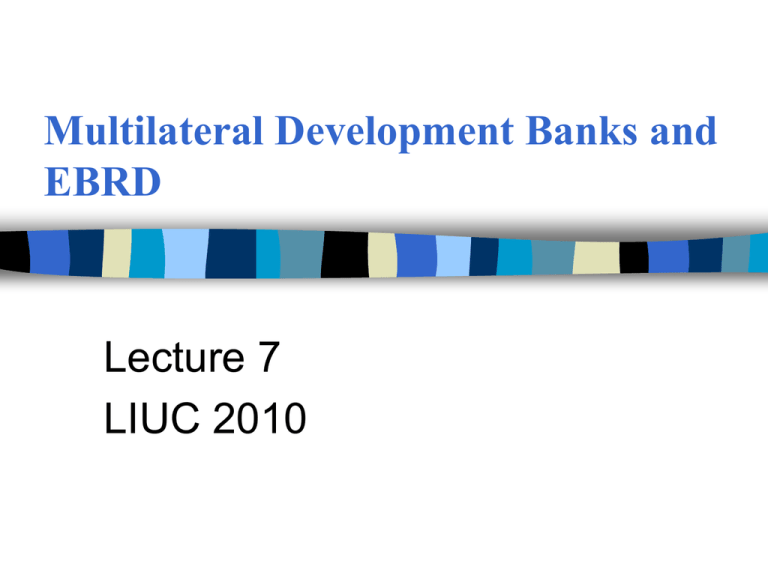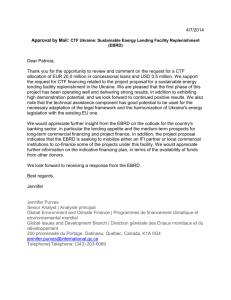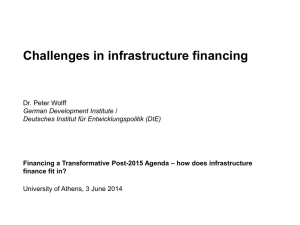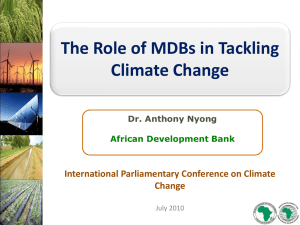Multilateral Development Banks and EBRD Lecture 7 LIUC 2010
advertisement

Multilateral Development Banks and EBRD Lecture 7 LIUC 2010 Multilateral Development Banks (MDBs) MDBs are institutions that provide financial support and professional advice for economic and social development activities in developing countries. The term Multilateral Development Banks (MDBs) typically refers to the World Bank Group and four Regional Development Banks: The African Development Bank (AfDB) The Asian Development Bank (ADB) The European Bank for Reconstruction and Development (EBRD) The Inter-American Development Bank Group (IADB) The World Bank Group The World Bank Group is owned by 187 member countries It is made up of two development institutions - the International Bank for Reconstruction and Development (IBRD) and the International Development Association (IDA) The IBRD focuses on middle income and creditworthy poor countries, while IDA focuses on the poorest countries in the world. They provide low-interest loans, interest-free credits and grants to developing countries for a wide array of purposes that include investments in education, health, public administration, infrastructure, financial and private sector development, agriculture, and environmental and natural resource management. The International Finance Corporation (IFC) is also a member of the Group. It provides investments and advisory services to build the private sector in developing countries African Development Bank Shareholders: 53 African and 24 nonAfrican countries Mission: to promote sustainable economic growth and reduce poverty in Africa Total Employees: 1,491 Headquarters: Abidjan, Côte d’Ivoire Temporary relocation: Tunis, Tunisia Asian Development Bank Shareholders: 67 members, of which 48 from the region and 19 from other parts of the globe. Mission: to help its developing member countries reduce poverty and improve the quality of life of their people Total employees: 2,500+ Headquarters: Manila Although most lending is in the public sector - and to governments - ADB also provides direct assistance to private enterprises of developing countries through equity investments, guarantees, and loans Inter-American Development Bank (IADB) The IADB group is composed of the Inter-American Development Bank, the Inter-American Investment Corporation (IIC) and the Multilateral Investment Fund (MIF). The IIC focuses on support for small and medium-sized businesses, while the MIF promotes private sector growth through grants and investments, with an emphasis on microenterprise. Shareholders: 48 of which 26 borrowing and 22 non borrowing Mission: combat poverty and promote social equity through programs tailored to local conditions. Total employees: 1,745+ Headquarters: Washington D.C. European Bank for Reconstruction and Development (EBRD) Shareholders: 61 countries and 2 intergovernmental institutions (EIB and European Community) Mission: promotes entrepreneurship and fosters transition towards open and democratic market economies in Central-Eastern Europe and Central Asia (former soviet bloc). Total employees: 1,260+ Headquarters: London What do MDBs do? The MDBs provide financing for development through the following: Long-term loans, based on market interest. For funding these loans the MDBs borrow on the international capital markets and re-lend to borrowing governments in developing countries. Very long-term loans (often termed credits), with interest well below market interest. These are funded through direct contributions for governments in donor countries. Grant financing is also offered by some MDBs, mostly for technical assistance, advisory services or project preparation. MDB Response to the Financial Crisis While the IMF is the focal point for the response to the systemic liquidity threat, the MDBs play a critical complementary role in limiting the spread and the impact of the crisis by: Financing for fiscal measures targeted towards maintenance of jobs and social protection of the poor Closing gaps and mitigating rollover risks in project financing, including infrastructure directly and by crowding in private and other official financing Catalyzing trade financing Supporting financial systems and credit flows to private sector and SMEs How MDBs have responded to the crisis Acceleration and expansion of lending Streamlined facilities made available Increased flexibility to meet the varying needs of emerging markets and developing countries Provided much larger scale of financing than anytime in their history: they are on track to deliver the promised $100 billion in additional lending. MDBs’ role after the crisis Even beyond the crisis, the global financial environment is likely to be much more difficult than in the past years. MDBs can still play a critical role in mobilizing long-term market financing through its direct borrowing and by catalyzing stable private sector financing. MDBs remain the most effective channel to provide concessional financing for low income countries. New challenges: climate change and food security, global in nature and require globally coordinated action. What’s next? Need for a clear and shared vision and strategy on the role of the MDBs Strengthen and reform the global development architecture for responding to the world’s long-term challenges. Increase coordination with other bilateral and multilateral institutions. Key to learn lessons from the crisis. This includes: promote greater use of guarantees to provide insurance and catalyze private financing, simplify lending requirements, shift from an excessive focus on ex-ante safeguards and conditionality to country systems and expost evaluation… EBRD and its role in the crisis The spread of the crisis across the region Aug 07- Sep 08 Most transition economies remained largely unaffected, with the exception of Kazakhstan and the three Baltic countries, where credit reversal had started before the onset of the global crisis. Sept 08 - Mar 09 The crisis hit hard following the collapses of Lehman Brothers and Washington Mutual in the United States in mid-Sept. Risk premiums shot up, cross-border net lending turned negative, and export volumes contracted. FDI flows also declined, although net inflows remained positive. Sharp economic contraction in many countries. April 2009-June 2009 In line with the general recovery in international financial markets, regional financial indicators began to point upward . At the same time, the effects of the financial and real shocks began to be felt in the corporate, household, and banking sectors, with rises in unemployment, corporate insolvencies and non-performing loans. H2 2009 – present signs of recovery, but a lot of heterogeneity Ebrd: Transition report 2009 Domestic policy challenges Monetary and fiscal policies: no one-size-fits-all. Right policies depend on: strength of public balance sheet, credibility of monetary and fiscal institutions, currency composition of debt, domestic inflation dynamics, external and public financing constraints. The overriding challenge (almost everywhere): to protect the core banking system and SME lending. Another key challenge: maintaining SME financing Why the need for an international and coordinated policy response International dimension was critical because of lack of private sector financing Coordination is critical because of massive cross-country externalities: – Trade and financial integration carry the effect of both the crisis and the crisis response across borders – Competition for a common pool of private resources (global savings and liquidity). What did EBRD do to respond to the crisis? Increased business volume from €5.1 bln in 2008 to €8 bln in 2009 Recapitalised sound banks Stepped in support for small and medium-sized enterprises Expanded trade facilitation programme to maintain vital trade flows to and from the region Worked more closely in coordination with other IFIs Continued to finance key infrastructure in the region The Joint IFI Action Plan for Eastern European Banking Systems European commercial banks have deeply invested in the EE region. In Feb 2009 a common initiative of EBRD, EIB and World Bank Group was announced with the following objectives: Common needs assessment both at the level of Eastern European banking systems and at the bank group level A coordinated approach to refinancing and recapitalization, with burden sharing across IFIs, home and host countries, and parent banks. IFI contribution: about € 25 bn during 2009-10 Capital increase As a consequence of the crisis and the need to increase its investment activity in the region, in May 2010 EBRD Governors approved a capital increase of €10 billion, which will allow the Bank to accomplish its mandate and safeguard its financial stability, while preserving its AAA rating. € 1 billion is paid-in through reserve and €9 billion is callable capital New challenges Foreign vs local currency: the new initiative Graduation and post-graduation Climate change - A new role for the Bank? The local currency and local capital market development initiative Why? Reduces systemic risks associated with FX lending to unhedged borrowers Encourages domestic saving and investment Why now? Significant post-crisis common ground Regulators moving forcefully against FX Post-crisis macro conditions start to make local currency a more realistic proposition The effects of the crisis on graduation The global financial crisis has revealed the fragility of some past achievements in transition terms and has sharply increased demand for EBRD finance in the form of crisis response. This has delayed the process of graduation, even if has not changed the Bank’s strategic orientation. The EU-7 countries that were on the path to graduation before the crisis have now postponed this objective to the end of 2015. Following graduation, the Bank will consider selective post-graduation operations in a manner consistent with its mandate. A new role for EBRD as an environmental bank? The development of energy efficient and low carbon economies remains a major transition challenge for the EBRD region. The Bank has promoted energy efficiency since the early 1990s, in view of the serious energy inefficiencies in the region’s capital stock. The EBRD’s mandate and business model has allowed it to develop great expertise, especially in the area of mitigation. The Sustainable Energy Initiative: through the initiative, launched in 2006, the EBRD is already achieving emission reductions at a large scale (similar to that of France) and at attractive economic terms. The international community has now endorsed the need for deep cuts in global carbon emissions and some shareholders would like EBRD to be more and more involved in climate change mitigation.


